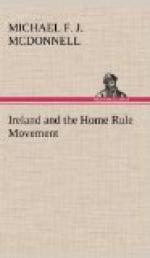The land system, which is only now disappearing, served, moreover, not to inculcate habits of thrift, but positively as a discouragement of economic virtues. Until the legal recognition of tenant-right had been secured, the tenant who made improvements was liable to have his rent raised, and was aware that he had no legal right to compensation for them on his removal from the holding. Further, the judicial fixing of rents, which, as the time for rent revision has approached, has presented to the tenant the temptation not to make the best of his land, and so run the risk of an augmentation of rent, has been a source of insidious demoralisation to the occupant of the soil.
The social upheaval resulting from land purchase will nowhere be more marked than in this respect in the stability which it will produce in the financial conditions of the country, and it may be expected to do something to remedy the lamentable state of things which so far has but little altered from that of twenty years ago, when it was estimated that five-sixths of the total capital of the country was invested abroad. A great opportunity presents itself at the present moment. It was stated a few years ago that eleven millions of rent were spent out of the island. At this day when, under the Land Purchase Act, an immense amount of property is being realised, the patriotic Irish landlord seeking an investment for his money can, by starting industries in Ireland, at one and the same time do a patriotic work by providing against the stream of emigration, and can secure a safe and profitable investment for his purchase-money. There are very nearly eighty million pounds of capital to be set free under the Act, and it is scarcely too much to expect that a large proportion of it will be invested by the expropriated landlords in their own country. The possibility of an industrial revival in Ireland is well illustrated by the increase in the number of co-operative societies, in which there are at the present day 100,000 members, while less than twenty years ago there were only fifty.
The effect of the Dairy, Agricultural, and Poultry Societies is very important, but perhaps of still greater importance are the Raffeisin banks, which aim at the promotion of farming by means of co-operative credit. The loans which they make, at an interest of five per cent. or six per cent., are dealing a death-blow at that curse of Irish life—the gombeen man, whose usury used to mount up to thirty per cent. The extremely rare cases of default in the repayment of these loans for agricultural purposes will not be surprising to those who recall the tribute paid by Mr. Wyndham, in connection with land purchase annuities, to the Irish peasant as a debtor whose reliability is unimpeachable. More than twenty years ago the Baroness Burdett Coutts made a loan of L10,000 to the fishermen of Baltimore, with a view to the development of their industry, and the unfailing punctuality with which payments were made afforded




